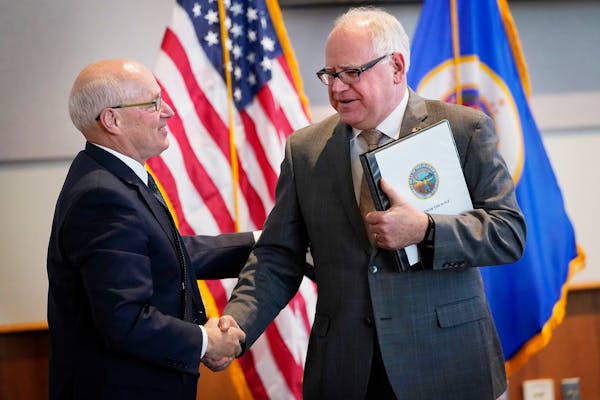The ideas started rolling in as soon as the surplus was announced.
Give it back to Minnesotans via tax breaks. Spend it on roads and bridges. Eliminate the tax on health care providers. Invest in affordable housing. Or rural broadband. Or public schools.
Minnesota appears likely to have an extra $1.3 billion in its two-year budget, state experts said Thursday at the big biannual budget forecast event.
Bam. Reporters' e-mail inboxes and social media feeds quickly swelled with the dashed dreams of yestersession.
The state teachers union Education Minnesota sent an e-mail saying the state should spend the money to train and retain school support staff, expand after-school services, increase the number of teachers of color or improve student mental health support.
Minnesota Chamber of Commerce President Doug Loon just offered one idea left on the cutting room floor in the last legislative session: "Joining the majority of other states that have fully conformed to the federal income tax business expensing rules."
The federal rules, which changed under President Donald Trump's 2017 tax bill, would allow farmers and small companies to write off certain property and equipment purchases within the first year. They also would raise the maximum deduction to $1 million.
Legislators tossed out a number of ideas in dueling DFL and GOP news conferences in the hours following the announced surplus, which was expected.
Sen. Ann Rest, DFL-New Hope, said lawmakers need to address the lack of affordable housing in the state.
House Minority Leader Kurt Daudt, R-Crown, irked DFL Gov. Tim Walz with his suggestion of eliminating the tax on health care providers, which Democrats fought hard to preserve. The agreement to extend the tax, with a slight drop in the rate, was a key piece of the end-of-session negotiations.
Walz said Daudt's idea is "not happening," and Senate Majority Leader Majority Paul Gazelka, R-Nisswa, said he doubts the provider tax will be revisited in the 2020 session.
Gazelka offered a number of other options, two of which were ideas Democrats also suggested.
Both Gazelka and Sen. Susan Kent, DFL-Woodbury, mentioned spending surplus money to improve school safety. And the Senate leader and Democratic House Majority Leader Ryan Winkler each suggested using some cash for transportation projects.
But hold up.
The forecast doesn't account for $1.2 billion in inflation in the next budget cycle, 2022 and 2023.
Winkler, DFL-Golden Valley, said that's the reason the House will be focused on one-time spending next year, as opposed to using the dollars to create ongoing programs and spending commitments.
Meanwhile, two House members and a senator have introduced bills requiring that future budget forecasts take into account the costs of inflation.
House Ways and Means Chairman Lyndon Carlson, DFL-Crystal, said his committee will look at that idea next session.
Jessie Van Berkel • 651-925-5044
jessie.vanberkel@startribune.com
Live video of man who set himself on fire outside court proves challenging for news organizations

Jill Biden rallies women, teachers for the Biden-Harris ticket in Bloomington speeches

